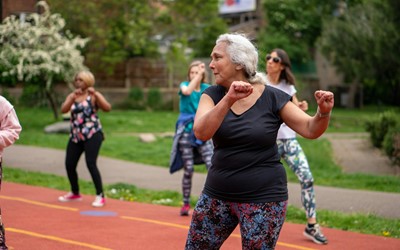
Two NIHR ARC North Thames-supported studies, published today in the Lancet Healthy Longevity, share significant findings detecting frailty in adults of all ages, offering promising new contributions to how frailty risk might be prevented throughout the life course.
The findings come from National Institute for Health and Care Research (NIHR)-funded studies led by researchers from UCL, the London School of Economics (LSE) and the University of Barcelona.
Using hospital data to understand frailty risk and costs across the life course
One of the studies, led by Professor Simon Conroy (UCL) and Professor Andrew Street (LSE) found that frailty risk can be identified in adults as young as 18 years old.
The study utilised the Hospital Frailty Risk Score (HFRS), which uses routinely-collected hospital data to identify older people at risk of poor outcomes due to hospital admissions.
Findings showed that increased frailty risk was associated with increased costs and longer hospital stays in people 18 years or older, until now considered only in adults over 75 years old.
For example, those aged 18-24 with high frailty risk, length of hospital stay was 4.5 days longer and costs were £796-£1,638 higher than for someone with a zero frailty risk.
This data could help identify patient populations that may benefit from additional care to prevent adverse outcomes later in life.
The HFRS is available to clinical teams across the NHS to record and track frailty risk throughout the life course. The project team has worked with NHS England to create frailty dashboards that supplement their existing use by including younger people.
Understanding frailty prevalence in homeless populations
The same issue of the Lancet Healthy Longevity features another ARC North Thames-supported paper by Jo Dawes, MPhil (UCL) that looks at frailty risk in people experiencing homelessness.
The paper finds that, for people experiencing homelessness, frailty prevalence is substantially higher.
The results are particularly stark among young people, where 26.6% of people experiencing homelessness aged 18-29 years were identified as frail.
By comparison, prevalence of frailty amongst the general population in this age group is only approximately 2% (according to a separate study from Canada).
These findings highlight that people living in extreme poverty, such as those experiencing homelessness, may become frail at a young age.
This research offers an opportunity to shape awareness and service design around frailty prevention in people experiencing homelessness. This is particularly important for those who may be ineligible to access care services due to their age, given that many frailty services in the UK include age criterion for acceptance of referral.
Tracking frailty and its implications
As Professor Simon Conroy (honorary professor, UCL Institute of Cardiovascular Science), says:
“At all ages, increasing frailty is linked to worse outcomes, ranging from disability, hospitalisation and death, and to worse financial or emotional well-being.
“While of course, the prevalence of frailty at younger ages is much less than in older people, our ability to track risk is highly valuable with regards to health prevention and reduction of time spent in hospital.
“Frailty-based risk assessments have the advantage of being highly holistic, taking account of wider elements of risk common in hospitalised such as physical or cognitive function and long-term medical conditions.
“The results raise valuable considerations of how routine measurement of frailty risk throughout adulthood might permit life-course interventions that could delay or prevent frailty and its related outcomes in later life.”
- Read about the full findings in The Lancet Healthy Longevity
- Access the HFRS tool here: https://ncdr.england.nhs.uk/ (requires a NHS.net account)
- Learn more about Professor Simon Conroy's study
- Learn more about Jo Dawes' study

 21 Aug 2025
21 Aug 2025


